“To be lost is to be fully present, to be fully present is to be capable of being in uncertainty and mystery — REBECCA SOLNIT, A Field Guide to Getting Lost
I originally planned on following the Dada route of creating a chance collage with some elements inspired by Jean Arp, Kurt Schwitters and Francis Picabia’s Dada Movement piece, but at the last minute I switched gears and decided to delve into the Letterist and Situationist International’s dérives that “sought to intervene in public process of “consuming” the “spectacle” of daily life... ” With the internet and social media, present day has even more chatter than the moving images and new cinema of the 50s and 60s. Part of the thought process for my algorithmic dérive is to go back to the mindset before smartphones and wifi, to be without the immediate responses of finding a destination quickly with Google Maps or sending a photo or a status update right away to all your friends and families, which in effect keeps you from being fully present or letting your mind wander to welcome happy accidents or chance encounters. I was also drawn to the psychogeography maps and the contemporary works of Sophie Calle’s photographs of re-familiarizing herself with the streets and people of Paris, as well as Rebecca Solnit’s book, A Field Guide to Getting Lost. New York City is very familiar to me, so the idea of getting lost and discovering new things about the city is something that I want to recapture and to also reveal inspiration for writing, photography and new meanings.
• • • • •
PROTOTYPE DESCRIPTION: An algorithmic dérive using a map of Manhattan, which is divided into 5″ x 7″ sections and shuffled together like a deck of cards. The participant picks a card from the stack which will then decide the area of the city to explore.

THINGS TO BRING (and not bring):
– Paper and Pen
– An envelope with an address of a family member, friend, foe or yourself. Add a stamp to the envelope.
– Camera (Preferably film or instant camera. For more of a challenge, limit the number of photos you take to 24 exposures or less and don’t use the delete button)
*Note: Try not to use your smartphones, laptops and ipads. If you must take it with you, bury it deep within your bag.
DIRECTIONS:
1. Pick up a random card from the stack to reveal a piece of a New York City map.
2. Once you arrive at your destination, walk around and take note of the first word that you see or hear that captures your attention. Write down the first letter of that word.
3. Find a public space, like a park, bench or cafe, where you can sit for a bit.
4. Count the number of people holding their smartphones and write that number down on a piece of paper. If you can observe what each person is doing on their phone, write down whether they are sending an email, checking Facebook, Snapchat or Instagram, looking at photos on their phone, looking at Google Maps, or are on a search engine?
5. Recall the first letter of the word that you wrote down. Take that first letter and think of a concept or idea that you can follow to help you explore your surroundings (Example: the letter “O” can be the word “Orange” ——> go around taking photos, drawing images or writing about or eating and tasting “orange” things that you see in your exploration of the area.)
6. Recall the number of people on smartphones that you saw when you sat down. That number will be the number of photos, drawings or lines that you need to write or capture on this journey. And if you were able to observe what a person was doing on their phone, reenact the action without a smartphone. (Example: replace the act of sending an email or text messaging with writing a letter or postcard to a friend and finding a mailbox to send it off; if you see someone on a search engine, keep your eyes out for a library).
7. At the end of the dérive, try to draw your path on the 5″ x 7″ map. Mark the spots on that map where you started and ended your journey, location of a mailbox if you mailed a letter, and anything that was significant to you.
DOCUMENTATION: By the end of the dérive, hopefully there will be a series of photographs, drawings or writing that transpired. Also by adding the path to the map, the participant can do a number of sections of the Manhattan map and piece them together in the sequential order of when it was done to create a brand new map or piece them together in it’s correct order for a personalized map. And adding a physical path on a map doesn’t necessarily have to be site specific, a mental psychogeography map can also be plotted instead.
INSPIRATION: Sophie Calle’s photographs in Paris















































You must be logged in to post a comment.